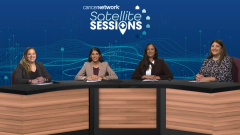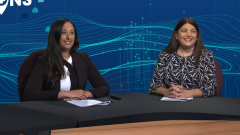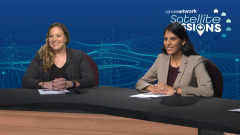
Expanding the Treatment Armamentarium in RRMM with Novel Therapies
Switching focus to the relapsed/refractory setting, panelists reflect on the treatment armamentarium available to patients with multiple myeloma at early relapse.
Episodes in this series

Transcript:
Krina K. Patel, MD, MSc: I think we can shift toward what do you do for first relapse? Let’s say there’s a patient who is transplant ineligible, gets DARA-REV-DEX [daratumumab, Revlimid, dexamethasone], and 5 years later is relapsing. We’ll give him a good response and the median PFS [progression-free survival]. What would you likely choose today as your next line therapy?
Tejo N. Musunuru, MD: I would still go with the standard second-line treatment options. If they didn’t get the quadruplet, obviously 5 years ago, probably not. I would go with what kind of PI [proteasome inhibitor] and immunomodulatory drug they got exposed to, which was probably Revlimid and either carfilzomib or Velcade. In that case, I would probably go with the second-generation drugs like ELO-POM-DEX [elotuzumab, pomalidomide, dexamethasone], or a combination. If they weren’t exposed to DARA [daratumumab] before, I’ll introduce daratumumab at that point.
Krina K. Patel, MD, MSc: What about you?
Melody R. Becnel, MD: I think it depends on what they had previously. So, if it was definitely daratumumab, lenalidomide, dexamethasone, then maybe in that patient population I would do a pomalidomide-based regimen just to get something different from Revlimid. Have they been on daratumumab continuously or not, and when was everything stopped? Because, technically, I’m not opposed to rechallenging with a CD38 monoclonal antibody, whether we do daratumumab again, or we do ISA [isatuximab]. I think the data are there. We showed that with some of our stuff, so I wouldn’t be opposed to doing that for the ease of tolerability.
Krina K. Patel, MD, MSc: I was going to say that for the transplant-eligible patients, for instance, who have gotten the quad. If they haven’t had daratumumab or a CD38, I definitely go to that. And usually, depending on if they’re high risk or not, I’m adding carfilzomib versus pomalidomide versus my frail patients who may get weekly bortezomib. We have a study called SWITCH, where we’re doing that, so it sort of depends on that. But if they’ve had daratumumab continuously, then likely I tend to go to carfilzomib, pomalidomide, or carfilzomib and something else at that point, or clinical trials of course, which we have lots of. Then, do you think it’s better to do use a CD38 up front or in the second line?
Tejo N. Musunuru, MD: I like them in the frontline setting. With all the data we have these days, especially with the new data with the quadruplets and the MRD [minimal residual disease] data we are getting, I like daratumumab in the front line.
Melody R. Becnel, MD: Same.
Krina K. Patel, MD, MSc: Perfect, I agree, again. This is never what our tumor board is like.
Tejo N. Musunuru, MD: That’s because we don’t have actual patients here.
Krina K. Patel, MD, MSc: Exactly. We always find something that’s different. We’re going to go a bit into the really relapsed/refractory [setting] right now, some of the novel immune therapies, which we’re really excited about. So, the mechanism of action of bispecifics. Dr Ahmed, you’ve had patients with teclistamab on the inpatient service.
Sairah Ahmed, MD: Yes. I think there is this new wave of treatments that, prior to the last few years, we didn’t have any experience with. Whether it’s a bispecific that’s CD3, BCMA, or a bispecific that’s with a CD19, CD20 agent. Both on the myeloma and on the lymphoma side, we have a gluttony, I would say, not yet approved, but I think soon to be multiple options. With that, they are very different in terms of toxicity profiles. I’ll compare and contrast a bit teclistamab to the bispecific that was just approved for follicular lymphoma, which is mosunetuzumab, and the amount of regulatory control on giving teclistamab in comparison to mosunetuzumab. A lot of that comes down to the toxicity profile, because, while a lot of the clinical trials were done in very experienced centers that could mitigate toxicity, these are going to be agents that will be available to everybody around the country. I think that’s important to understand, that they’re not benign, and how we have to take care of patients who are receiving them. I think it’s an amazing time to be in hematology.
Krina K. Patel, MD, MSc: I completely agree with you, and I think now having had experience with our standard of care for teclistamab, we’ve been able to take patients off of our lists who have been waiting for CAR [chimeric antigen receptor] T-cell therapy for so long because we just didn’t have access. There are so many patients we’ve been able to treat, and it’s been, I think in that sense, a wonderful feeling of, “Oh my gosh, we have this new best therapy.” And the fact that [there was a] 64% response rate for these really relapsed/refractory patients. I will say there is grade 1 and 2 CRS [cytokine release syndrome], but less than the way I look at it, the lymphoma CAR T [therapies], I’m going to give it back to you a little. The lymphoma CAR Ts are probably the worst, then the myeloma CAR Ts, and then the bispecifics for myeloma. But we still have to keep an eye on this and monitor, especially infections. But again, to have CD3 for T cells, BCMA, and killing that myeloma, and a 64% response rate. It’s pretty phenomenal for a single agent. We’ve never had a noncell therapy, I have to say it that way now, but we’ve never had a noncell therapy get to that level of PFS [progression-free survival]. I don’t know if you’ve had any patients yet who you’ve treated, or if you’re on the service?
Melody R. Becnel, MD: I have, and I think the CRS is definitely less than CAR T. I’ve had 1 patient who, I would say for the most part, you’re only seeing it with the first administration and then it usually goes away. I did have 1 patient who had CRS with her second dose.
Krina K. Patel, MD, MSc: The second full dose.
Melody R. Becnel, MD: Yes. Other than that, it’s pretty well tolerated.
Krina K. Patel, MD, MSc: I think a lot of centers are trying to do it, instead of the 9 days of inpatient, making it 5 days, based on the REMS [Risk Evaluation and Mitigation Strategy]. There are certain centers that are doing it outpatient with TOCI [tocilizumab] or dexamethasone. I think we’ll see some of those data at ASCO [the American Society of Clinical Oncology annual meeting], so that’ll be interesting to see how can we now get patients out of the hospital, because that is the other piece. Our CAR T census has been very high, so to increase access.
Sairah Ahmed, MD: I think No. 1, it’s access, and No. 2, it’s being fiscally responsible. These are expensive drugs, and when you add on a hospitalization, that often makes it extremely expensive. We want insurance companies to pay for these because they’re fantastic. The response rates you’re quoting are in patients who are so heavily pretreated and refractory. This is not the front line or second line; this is fourth line and beyond. I think the other part of it is, we look at the toxicity with bispecifics and try to mirror it against CAR T, and I don’t think that’s necessarily true. I don’t think the CRS you see with bispecifics has the same progression as you see for CAR T. I think that it is probably construct-specific and disease-specific in terms of where you do see more CRS and more ICANS [immune effector cell-associated neurotoxicity syndrome]. You’re kind of on that line of, is this an infusion-related reaction, is this CRS? When you don’t have the risk of it progressing to a higher grade, I think most people feel fairly comfortable treating that patient with supportive care, or dexamethasone, or tocilizumab in the outpatient [setting], and not worrying that like 12 hours later when they’re at home, something really bad is going to happen.
Krina K. Patel, MD, MSc: I completely agree with that. Then any thoughts on others, because there are of course a lot more BCMA bispecifics that are in research and potentially coming down the road? Any of them, like ELRA [elranatamab] or TNB-383B, any of those that you think is different in terms of response, toxicity, or anything like that?
Melody R. Becnel, MD: Well, a non-BCMA one, cevostamab, I feel like, anecdotally has a slightly worse toxicity profile, but the responses are amazing. I think they’re all fantastic, and it gives us so many more options for people who have had prior BCMA-targeted therapies, we have these other targets. I would say just anecdotally, there’s slightly more toxicity.
Krina K. Patel, MD, MSc: I think different targets are going to be different. It’s FCRH5 for cevostamab, then GPRC5D for talquetamab, which we’ll come back to in a second. I do think BCMA, being part of the myeloma progression, and it leads to proliferation, and being on late B cells, I think the infection rates seem to be a bit higher with the BCMAs versus cevostamab. We do see neutropenia that happens, and maybe infection is more related to that. Then, this fixed dosing versus not. Cevostamab is the one that’s fixed dosing versus not for some of the other ones. I think there’s a lot that hopefully we’ll be able to learn from all these different ones.
Transcript edited for clarity.
Newsletter
Stay up to date on recent advances in the multidisciplinary approach to cancer.






















































































